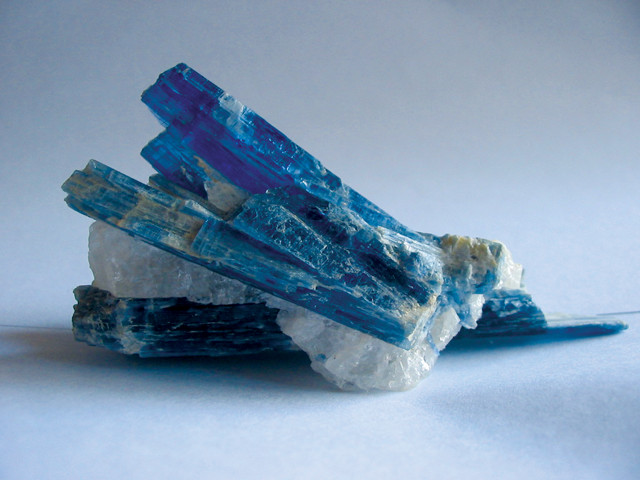
by U.S. Geological Survey Wednesday, June 13, 2018
Arnold O. Tanner, a mineral commodity specialist for the U.S. Geological Survey, compiled the following information on kyanite and related minerals, which are critical components of refractory (heat-resistant) and ceramic products.
Kyanite and the related minerals andalusite and sillimanite are anhydrous aluminum silicate polymorphs with the same chemical formula, but with different crystal structures and physical properties. These minerals form during metamorphism of clay-bearing sedimentary rocks or in pegmatites. In the United States, where kyanite is prevalent, these three minerals comprise the kyanite minerals group. It is also known as the “sillimanite group” where sillimanite is more common, particularly in India. The three minerals form under slightly different conditions and rarely occur together. They are composed of about 63 percent alumina and 37 percent silica. When “calcined,” or heated to 1,250 to 1,500 degrees Celsius, they convert to about 88 percent mullite and 12 percent silica (the percentages depend on grain size, impurities present and rate of temperature increase).

The name of the mineral kyanite was derived from the Greek word kyanos, which means "dark blue." Credit: Aelwyn/GFDL, Creative Commons
Mullite is rarely found in nature in economically viable quantities, but is typically the most preferred of these four aluminosilicate varieties because of its superior strength and refractory (heat-resistant) properties. Mullite produced by calcining aluminous and siliceous materials, such as kaolin and bauxitic clays, is referred to as synthetic mullite.
Ninety percent of the consumption of kyanite minerals group and mullite is for the production of refractories — materials that can withstand high-temperature environments, generally in excess of 1,100 degrees Celsius. Refractories are used to line the inside of furnaces, kilns and other containers that come in contact with molten metal and glass. The iron and steel industry consumes 50 to 60 percent of refractories globally. Other examples include firebrick, insulating brick and refractory shapes.
The interlocking grain structure of the kyanite group minerals and mullite lends added mechanical strength to refractories and ceramic materials. When calcined, the minerals expand volumetrically by differing amounts (3 to 25 percent), making them suitable for a variety of applications. Other end uses include brake shoes and pads; ceramic products such as electrical insulating porcelains, bathroom fixtures and whiteware, such as dishes and pottery; foundry products and precision casting molds; and spark plugs.
The United States is the world’s leading producer of kyanite and mullite, all produced by the Kyanite Mining Corporation from kyanite-bearing quartzite deposits in central Virginia. Another U.S. company produces synthetic mullite by calcining kaolin and bauxitic clays from mines in Georgia. In North Carolina, a pyrophyllite-andalusite-sericite deposit is mined, and the andalusite is not separated out from the mined mixture. It is sold in various blends with the other minerals to producers of ceramics and refractories.
For more information on the commercial use of the kyanite minerals group and mullite, visit http://minerals.usgs.gov/minerals.
Kyanite production and consumption:
In 2012, about 98,500 metric tons of kyanite and mullite were produced in the United States, with an estimated value of $31 million. In addition, about 40,000 metric tons of synthetic mullite were also produced, with an estimated value of $13 million.
In 2012, the United States imported about 3,500 metric tons of kyanite group minerals; more than 75 percent of this was andalusite from South Africa.
World mine production of kyanite group minerals and mullite was an estimated 400,000 metric tons in 2012.
Fun facts:
Although usually blue, kyanite also occurs in brown, gray, green, orange, white and black. It may be colorless and translucent or, as purity increases, transparent.
Kyanite most commonly occurs in long, thin, blade-like crystals.
Some New Age practitioners believe that kyanite crystals offer health benefits and improve dream recall. Different colors are said to have different effects, from boosting the immune system to assisting in weight loss.
© 2008-2021. All rights reserved. Any copying, redistribution or retransmission of any of the contents of this service without the expressed written permission of the American Geosciences Institute is expressly prohibited. Click here for all copyright requests.